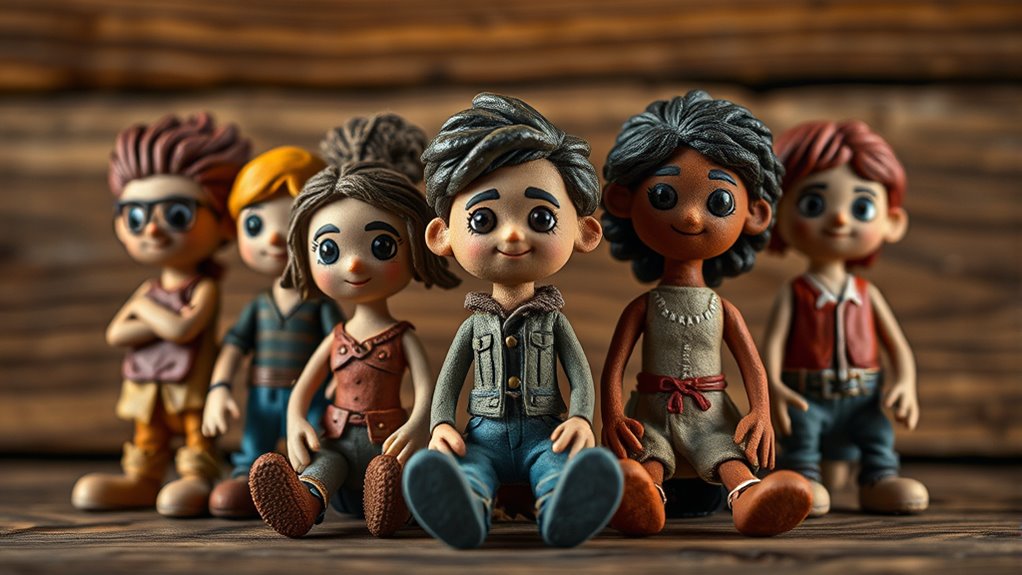Traditional personas often oversimplify user behavior, missing emotional depth and cultural influences. To go beyond, focus on crafting archetypes built around core traits like motivations, values, and behaviors that reflect authentic insights. These archetypes help you understand deeper drivers behind decisions, enabling more meaningful product designs. By integrating layered, dynamic archetypes into your strategy, you can better resonate with users and evolve your approach over time. Keep exploring to discover how to make archetypes truly impactful.
Key Takeaways
- Archetypes capture universal human motivations and emotional drivers, enabling more authentic product resonance than traditional personas.
- Developing layered, multidimensional archetypes involves cultural insights, behavioral observations, and storytelling techniques.
- Integrating archetypes with personas provides deeper understanding, guiding targeted features and emotional engagement strategies.
- Archetypes inform branding and design choices by aligning visuals, messaging, and interactions with core character traits.
- Evolving archetypes into dynamic, behaviorally-informed models allows real-time adaptation to user shifts and enhances product relevance.
Understanding the Limitations of Traditional Personas

Traditional personas often seem like a helpful shortcut for understanding your target audience, but they have significant limitations. They tend to oversimplify complex human behavior and overlook how cultural influences shape decisions and perceptions. Relying solely on these profiles can lead you to misinterpret motivations, especially when emotional intelligence varies across different groups. People don’t always fit neatly into predefined categories, and ignoring cultural nuances may cause you to miss subtle cues that drive user engagement. Furthermore, traditional personas rarely account for emotional depth or context, which are crucial in understanding user needs authentically. By focusing only on surface-level traits, you risk designing products that don’t truly resonate with diverse audiences or adapt to their evolving emotional and cultural landscapes. Considering vetted demographic data can provide more accurate insights into your audience’s behaviors and preferences.
Defining Archetypes and Their Core Characteristics

Archetypes are built around core traits that capture the essence of a persona, making them more adaptable and insightful. You need to identify their fundamental characteristics and how these traits influence behavior and decision-making. Recognizing these key attributes helps you create more meaningful and flexible archetypes that go beyond surface-level profiles. For instance, understanding power output and performance capabilities of electric dirt bikes can inform how you develop archetypes related to thrill-seekers or off-road enthusiasts.
Fundamental Archetype Traits
Understanding the core traits of fundamental archetypes is essential for recognizing their influence on behavior and decision-making. These traits shape how archetypes perceive the world and respond to situations, often rooted in cultural influences and emotional drivers. For example, an archetype driven by security values stability and consistency, while one motivated by adventure seeks novelty and risk. Recognizing these traits helps you predict their reactions and preferences. Core characteristics include motivations, values, and typical behaviors that define each archetype. By understanding these traits, you can craft more authentic and targeted products that resonate deeply. For instance, knowing how bike maintenance impacts an archetype’s perception of reliability can inform product design. Remember, these traits are the foundation, guiding how the archetype interacts with your offerings and the choices they make. This insight enables you to develop more compelling, relevant experiences.
Distinguishing Key Attributes
Recognizing the key attributes that define each archetype allows you to differentiate their unique identities and how they behave. To do this effectively, focus on core characteristics like emotional intelligence, which influences how they respond to challenges and interact with others. Consider cultural influences that shape their values, motivations, and decision-making processes. These attributes help you understand what drives each archetype’s preferences and reactions. By clearly identifying these traits, you can tailor your product strategies to resonate more deeply. Remember, archetypes aren’t just stereotypes—they embody consistent patterns of thought, feeling, and behavior. Pinpointing their key attributes ensures you capture their essence, enabling you to design experiences that genuinely connect and foster loyalty.
Differentiating Between Personas and Archetypes

While personas and archetypes are often used interchangeably in design and storytelling, they serve distinct purposes that you should understand. Personas focus on detailed user profiles, emphasizing specific needs, behaviors, and demographic data. They often highlight emotional drivers that influence decision-making and are shaped by cultural influences. Archetypes, however, represent universal symbols or character types that resonate across cultures and time periods. They evoke shared emotions and deep-seated motivations rather than individual traits. While personas help you tailor products to specific user segments, archetypes provide a broader, more instinctive understanding of human behavior. Recognizing this difference allows you to craft more meaningful experiences by blending detailed insights with universal, emotionally driven archetypes.
Identifying Driving Motivations and Values

To truly connect with your audience, you need to identify what drives their motivations and values beneath their behaviors and preferences. Start by exploring their motivational drivers—the underlying reasons that influence their actions and decisions. These could include desires for security, belonging, achievement, or independence. Understanding their core values helps you see what genuinely matters to them, shaping their priorities and choices. Ask questions like, “What do they value most in life or in a product?” and observe patterns in their behaviors. By uncovering these fundamental aspects, you gain insights into why they make certain choices, allowing you to craft archetypes that resonate deeply and inform product decisions that align with their true motivations.
Techniques for Developing Rich, Layered Archetypes

Developing rich, layered archetypes requires more than just listing demographic traits or surface-level preferences. To create authentic archetypes, you need to tap into emotional resonance—understanding what truly motivates and challenges your users. Conduct in-depth interviews, immerse yourself in their stories, and observe their behaviors in real contexts. Incorporate cultural influences by examining how cultural backgrounds shape attitudes, habits, and decision-making processes. Use storytelling techniques to craft detailed narratives that reflect their hopes, fears, and aspirations. Incorporate multimedia research—photos, videos, diaries—to capture nuanced aspects of their lives. By blending emotional insights with cultural context, you build multidimensional archetypes that resonate deeply, guiding product decisions with empathy and cookie categories.
Applying Archetypes to Product Design and Strategy

How can you effectively translate rich archetypes into actionable product design and strategy? Start by aligning your features and messaging with the emotional resonance these archetypes evoke. Understand the cultural influences that shape your users’ perceptions and behaviors, ensuring your design feels authentic and relatable. Use archetypes to inform user journeys, creating experiences that resonate on a deeper level. Focus on storytelling elements that reinforce the archetype’s traits, fostering stronger connections. Incorporate cultural nuances to make your product feel personalized and relevant across different markets. By doing so, you transform abstract archetypes into tangible design principles, guiding your team to craft solutions that genuinely resonate with users’ identities and values—ultimately driving engagement and loyalty. Additionally, leveraging living room design elements and furniture choices can help create environments that reflect and support these archetypal identities, enhancing user experience and emotional connection.
Case Studies: Successful Use of Archetypes in Product Development

Real-world examples show how archetypes shape product development, leading to more targeted features and better user engagement. When you understand these archetypes, you can make design choices that truly resonate with your audience. These case studies demonstrate the tangible impact of using archetypes to refine and optimize products. Additionally, leveraging data privacy challenges helps ensure that products are both user-centric and compliant with evolving regulations.
Real-World Archetype Applications
Have you ever wondered how archetypes translate from theory into tangible product success? In real-world applications, companies harness archetypes to create emotional resonance, connecting deeply with their audience. For example, a global fitness brand used cultural influences to develop a “Motivator” archetype, inspiring users across diverse backgrounds by emphasizing universal themes of perseverance and self-improvement. This approach helped foster loyalty and engagement by aligning messaging with shared values. Another case involved a tech startup that crafted a “Discoverer” archetype, appealing to adventurous spirits by tapping into local cultural narratives. These applications show how understanding cultural influences and emotional needs allows you to design products that resonate authentically, driving user satisfaction and loyalty. Recognizing specific dog breed names and their personalities can also inform product branding and marketing strategies, making connections even more meaningful. Archetypes, when grounded in real-world context, become powerful tools for meaningful product development.
Impact on Design Choices
When companies incorporate archetypes into their design process, they directly influence product features, visuals, and user interactions to create a cohesive experience. By understanding archetypes’ emotional resonance, you can tailor designs that evoke specific feelings, fostering deeper user engagement. Cultural influences play a significant role, guiding visual styles, color schemes, and messaging that resonate with target audiences. For example, a successful app tailored to a youthful demographic used vibrant visuals and playful interactions, aligning with their archetype’s energetic nature. This strategic alignment boosts user satisfaction and loyalty. Clear archetype-driven design choices ensure consistency across touchpoints, making users feel understood and connected. Additionally, integrating crochet styles for locs into product customization options can enhance user personalization, aligning products with specific cultural or stylistic archetypes. Ultimately, leveraging archetypes enables you to craft products that resonate emotionally while respecting cultural nuances, leading to more successful and meaningful user experiences.
Engaging Teams With Archetype-Based User Insights

Using archetype-based user insights can substantially boost how your team understands and connects with target audiences. These archetypes bring emotional resonance, helping team members see beyond demographics to the motivations and feelings that drive behavior. By highlighting cultural influences, archetypes make insights more relatable and tangible, fostering empathy across your team. Sharing these vivid, story-like profiles encourages collaboration, as everyone visualizes the user’s perspective. This shared understanding aligns product decisions with genuine user needs, creating a more unified approach. When your team taps into these archetypes, they’re better equipped to design solutions that resonate emotionally and culturally, ultimately driving deeper engagement and meaningful connections with your audience. Additionally, incorporating water-related themes can evoke a sense of refreshment and vitality, making your personas even more compelling and memorable.
Evolving Your Approach: From Static Models to Dynamic Archetypes

While static archetypes have long served as useful tools for understanding users, evolving your approach means embracing dynamic models that reflect real-time changes in behavior and context. By integrating behavioral segmentation, you can group users based on current actions and preferences, making your archetypes more responsive. Emotional mapping adds depth, revealing how users feel at different touchpoints, which influences their decisions. Dynamic archetypes adapt as user behaviors shift, allowing you to refine your product strategies continuously. This approach helps you stay aligned with evolving user needs and foster empathy. Moving beyond static models empowers you to create more relevant, personalized experiences, ultimately driving better engagement and loyalty. It’s about transforming archetypes from fixed labels into living representations of your users. Incorporating mindfulness techniques such as visualization and sound meditation can further enhance your understanding of user emotions and needs, enabling more compassionate and effective product development.
Frequently Asked Questions
How Do Archetypes Adapt to Evolving User Behaviors Over Time?
You need to understand how archetypes adapt to evolving user behaviors over time. As behavioral shifts occur, your archetypes should evolve accordingly, reflecting new motivations and preferences. Regularly gather user feedback and analyze data to identify changes in behavior. By updating your archetypes, you guarantee they remain relevant, helping your product better meet user needs and guide decision-making effectively, even as user behaviors continue to shift.
Can Archetypes Be Integrated With Existing User Segmentation Methods?
You can definitely integrate archetypes with your existing segmentation strategies by focusing on data integration. Combine behavioral data, demographics, and psychographics to develop archetypes that complement your current segments. This approach enriches your understanding of user needs, allowing you to tailor products more effectively. By merging archetypes with segmentation, you create a more nuanced view of your users, ultimately improving decision-making and personalized experiences.
What Are Common Mistakes to Avoid When Developing Archetypes?
Mistaking archetypes for detailed personas leads to misconceptions pitfalls, causing you to overlook unique user needs. Avoid overgeneralization risks by recognizing that archetypes are broad, not exhaustive, representations. Don’t assume one archetype fits all; instead, refine your archetypes with nuanced insights. Keep your focus on authentic user behaviors rather than stereotypes, ensuring your archetypes truly guide product decisions without falling into the trap of oversimplification.
How Do Archetypes Influence Prioritization in Product Roadmaps?
Archetypes shape your prioritization by providing clear persona alignment, helping you focus on features that truly matter to your target users. When you understand your archetypes, you can prioritize features that resonate with their needs and behaviors, ensuring your product appeals to the right audience. This targeted approach streamlines your roadmap, reduces wasted effort, and boosts user satisfaction, ultimately driving better product decisions.
Are There Tools or Software That Facilitate Archetype Creation?
Isn’t it intriguing how tools turn data into stories? For archetype creation, you can use user research platforms like Userforge or UXPressia, which help visualize personas and archetypes through data visualization. These tools make it easier to synthesize insights, enabling you to craft detailed archetypes. They streamline the process, helping you focus on what really matters—understanding your users and shaping better product decisions.
Conclusion
As you weave rich archetypes into your product journey, imagine them as vibrant threads in a tapestry, each revealing deeper user truths. Moving beyond static personas, you craft dynamic stories that breathe life into your decisions. With every insight, you’re painting a clearer picture of your users’ world—guiding your strategy like a compass through uncharted waters. Embrace this evolution, and watch your product truly resonate, inspiring loyalty and connection at every turn.









